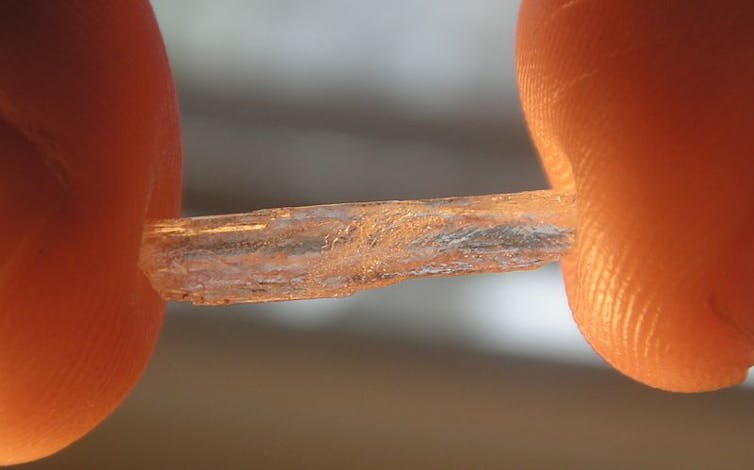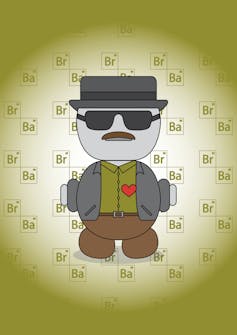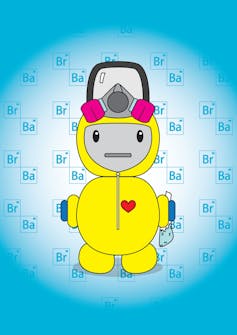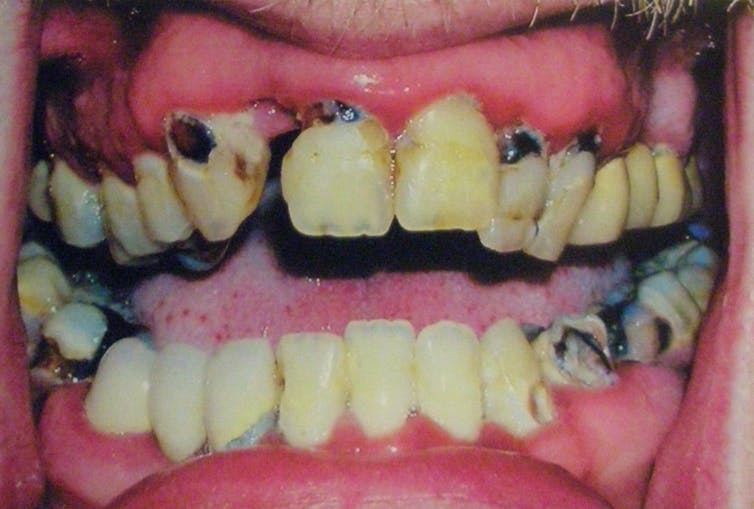Crystal meth has at least two faces, in common with those people unfortunate enough to succumb to its charms, as these horrific before-and-after pics show. I’d like to look at the drug chemically, to shine a light on what it does.
As written about previously on The Conversation, Australia has a particularly strong relationship to the drug. Approximately 2.5% of people over the age of 14 have used the drug in the last year, a rate far higher than in the US, Canada or the UK.
Far from being glorified, the drug also plays a starring role – alongside Bryan Cranston and Aaron Paul – in AMC’s critically-acclaimed television series Breaking Bad, currently airing its fifth and final season.
Crystal meth – also known as ice – is a form of methamphetamine or, to give it its technical name, n-methyl-1-phenyl-propan-2-amine. Instead of being produced as a powder (as amphetamine, or speed, is) it’s made as large chunks that look like crystals (as per the image below). Producing it as a solid lump can change the way methamphetamine is absorbed by our bodies.

Methamphetamine is a stimulant, with common side-effects including euphoria, increased alertness, talkativeness, panic, excessive sweating and – as portrayed in the following video – compulsive fascination with repetitive tasks:
Nerves and chemicals
Amphetamines in general produce their stimulant action by acting on nerves that secrete biogenic amines.
Nerves conduct electrical signals through the body, almost, but not quite, like wires. Unlike wires, the nerves aren’t physically connected to their targets, be they a muscle cell, a glandular cell or another nerve. There is a gap the signal must jump.
Nerves get the signal across this gap by secreting chemicals, neurotransmitters, and there are a wide range of chemicals that are used:
- the biogenic amines, including norepinephrine and epinephrine (more commonly known as noradrenaline and adrenaline outside the US)
- amino acids (such as glutamate, which you can find in your miso soup)
- a gas, nitric oxide.
The huge variety of physiological processes that the nervous system coordinates is made possible by these varying neurotransmitters. The sympathetic nervous system, which speeds up our hearts in preparation for running away from danger, using noradrenaline (often referred to as the fight or flight chemical). The parasympathetic nervous system, which opposes the sympathetic nervous system, uses acetylcholine, the most common neurotransmitter.
Once the chemicals are released by a nerve impulse, they can’t keep hanging around or we would be in a state of permanent activation (or inhibition). They have to be gotten rid of quickly before the next nerve impulse arrives. Some of the chemicals, such as acetylcholine, are broken down by enzymes.
The biogenic amines are removed by protein structures known as monoamine transporters (MATs) in the nerve membranes.
What meth does
Amphetamines, like methamphetamine, look sufficiently like the biogenic amines that they block these pumps. But that’s not all: amphetamines that do get taken up into the nerve cells get put into the nerves stores of the biogenic amines, and push the real neurotransmitters out of the nerves.

The net result is that you end up with a lot of biogenic amine neurotransmitter hanging around and stimulating cells.
In the heart, noradrenaline released from nerves will stimulate the heart to beat faster and stronger, increasing your pulse and blood pressure. In the brain, a whole range of biogenic amines are released that can increase alertness, concentration, and energy.
Higher concentrations of methamphetamine can cause mania and euphoria through to paranoia and hallucinations through the higher levels of these same biogenic amines.
Because this stew of biogenic amines (noradrenaline, serotonin and dopamine) is being released in an uncontrolled manner you also get potentially dangerous rises in blood pressure, heart rate and body temperature (all physiological processes controlled by biogenic amines in the body).

And because dopamine, a critical link in the psychological reward pathway, is released (to ten times its normal levels) it produces addiction - powerful addiction. Methamphetamine is one of the most addictive substances we know of.
The crystal form is smokeable. The rush a user gets depends on how fast it gets into the body: swallowing it takes longer, injection is the fastest but of course carries risks from injection.
Smoking crystal meth gives a very rapid high without the risks of injection.
Also, orally-ingested methamphetamine goes straight to the liver, where it is metabolised, so less gets into the bloodstream than via smoking.
Withdrawal
Withdrawal from methamphetamine produces effects including depression, intense craving and anxiety – much of which can be explained in chemical terms.
The stew of biogenic amines released while using the drug has multiple effects: they increase metabolism and decrease appetite in the short-term (amphetamines used to be used for weight loss).
Long-term behavioral problems result in malnutrition. Then there are chronic sleep problems and of course there is the increased probability of disease for those users who inject methamphetamine. All this combines to produce physical deterioration.
And let’s not forget “meth mouth”, the abnormal loss of teeth and accelerated tooth decay:

Sympathetic stimulation causes all sorts of secretion to stop (drugs which mimic noradrenaline are in our cold and flu medicines to stop runny noses), including saliva secretion.
This results in an increased risk of tooth decay that, combined with behavioural problems (meth addicts, we might assume, don’t prioritise brushing their teeth) and poor eating habits, means teeth are rapidly lost.
The high levels of biogenic amine release can also damage the heart and blood vessels, leading to cardiovascular problems; and high levels of dopamine release can damage the dopamine containing nerves that control movement, with a high risk of Parkinson’s disease.
There are other adverse effects – (suicide, psychosis) – but I think you get the idea.
Breaking Bad has put crystal meth use at the front and centre of the TV-watching public’s minds – both the fleeting highs and almost unimaginable lows. In this we have a case of art, quite disturbingly, mimicking life.

